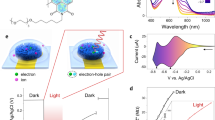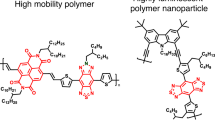Abstract
THE transistor, in its various forms, is a three-terminal amplifying electronic device1. Transistors are usually based on inorganic semiconductors, such as silicon or gallium arsenide1, but there is increasing interest in the use of organic semiconductors2–1, motivated by their structural flexibility and tunable electronic properties. The organic transistors fabricated to date have used a conventional 'field-effect' architecture; unfortunately, such devices involve relatively long conduction pathways which, owing to the low carrier mobilities of the organic materials, render them inherently slow. In an attempt to circumvent this problem, we have developed a different device geometry, more closely related to that of the vacuum-tube triode. The structure consists of a thin film of a semiconducting polymer sandwiched between two electrodes, with the third electrode―a layer of a porous metallic polymer5― embedded within the semiconductor. The third electrode plays a role similar to that of the grid in a vacuum tube, controlling the current flow between the two outermost electrodes. This thin-film architecture reduces the length of the conduction pathway, resulting in a relatively fast response time and, in contrast to conventional field-effect transistors, does not require lateral patterning.
This is a preview of subscription content, access via your institution
Access options
Subscribe to this journal
Receive 51 print issues and online access
$199.00 per year
only $3.90 per issue
Buy this article
- Purchase on Springer Link
- Instant access to full article PDF
Prices may be subject to local taxes which are calculated during checkout
Similar content being viewed by others
References
Sze, S. M. Physics of Semiconductor Devices (Wiley, New York, 1981).
Burroughs, J. H., Jones, C. A. & Friend, R. H. Nature 325, 137–141 (1988).
Assadi, A. et al. Synth. Met. 37, 123–130 (1990).
Garnier, F. et al. Science 265, 1684–1686 (1994).
Yang, C. Y., Cao, Y., Smith, P. & Heeger, A. J. Synth. Met. 53, 293–301 (1993).
Bozler, C. O. et al. Surf. Sci. 74, 487–500 (1986).
Cao, Y., Smith, P. & Heeger, A. J. Synth. Met. 48, 91–97 (1992).
Parker, I. D. J. appl. Phys. 75, 1656–1666 (1994).
Yang, Y. & Heeger, A. J. Appl. Phys. Lett. 64, 1245–1247 (1994).
Yang, Y & Heeger, A. J. US Patent Applic. No. 08/227 979.
Reghu, M. et al. Macromolecules 26, 7245–7249 (1994).
Reghu, M. et al. Phys. Rev. B (in the press).
Yang, Y. et al. J. appl. Phys. (in the press).
Author information
Authors and Affiliations
Rights and permissions
About this article
Cite this article
Yang, Y., Heeger, A. A new architecture for polymer transistors. Nature 372, 344–346 (1994). https://doi.org/10.1038/372344a0
Received:
Accepted:
Issue Date:
DOI: https://doi.org/10.1038/372344a0
This article is cited by
-
Organic Devices: Fabrication, Applications, and Challenges
Journal of Electronic Materials (2022)
-
Organic conjugated polymers and polymer dots as photocatalysts for hydrogen production
Frontiers in Energy (2021)
-
Vertical organic field effect transistor: on–off state definition related to ambipolar gate biasing
Applied Physics A (2018)
-
Organic electronic solid state device: electrochemistry of material preparation
Journal of Solid State Electrochemistry (2017)
-
Polymer nanowire vertical transistors
Nano Research (2014)
Comments
By submitting a comment you agree to abide by our Terms and Community Guidelines. If you find something abusive or that does not comply with our terms or guidelines please flag it as inappropriate.



